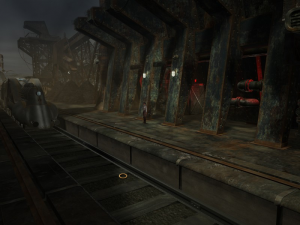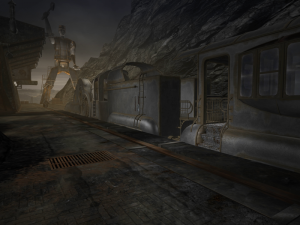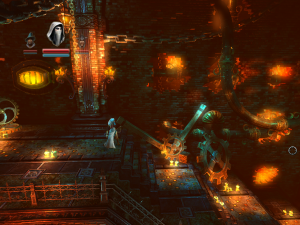Spider: The Secret of Bryce Manor
So, let’s have some more iOS. Spider: The Secret of Bryce Manor is a title that I remember being praised as innovative, early on in the short history of the platform. It’s certainly different in important ways from comparable games on other platforms, in that it’s designed from the ground up for the affordances of a touchscreen. At first thought, it may seem like a touchscreen, barring the multitouch stuff that most apps seem to support (scrunch to resize), just provides a subset of what you get from a mouse — basically, everything but hover effects. But it turns out that even the actions that both sorts of device support are significantly different. The customary way of dragging things in iOS takes a moment to lock in, and is therefore awkward to use in time-sensitive situations like games (as the iOS port of Gemcraft shows). Directional swipes, on the other hand, can be awkward with a mouse, but are one of the most natural actions in the world on a touchscreen. And so Spider uses swipes for one of its most-oft-repeated actions: jumping.
This is more natural than it sounds, because these aren’t Mario-style jumps that just give you a sudden jolt of upward velocity. You’re jumping in an arbitrary direction, and your trajectory usually doesn’t get a chance to arc very much, so it’s intuitive to think of the swipe as defining a line. This is because the player character of this game — actually, before I go into details, that’s another point worth pointing out: that this game has a player character, with an avatar that you move around on the screen, which is something that seems to be less common in touchscreen games than on platforms with keyboards or joysticks. The PC in this game is literally a spider, capable of crawling on walls and ceilings. Since the presentation is 2D and vertically-oriented, this means that you really have only two directions of movement on these surfaces. In a sense, you could consider it a 2D platformer, but it’s also sort of a territory-capture game, like Qix. Your goal isn’t to get from point A to point B, but to eat bugs, and to eat bugs, you have to build webs, ideally making them as big as you can given the constraints of the level geometry and your limited resources.
Webs are the only places where your direction of movement isn’t constrained. The way you build a web is actually pretty similar to the way a real spider builds the basic framework at the beginning of spinning. Before you swipe to jump, you can optionally tap the screen to indicate that you want to make a line of silk between your current location and the point where you land. So, it’s essentially line-drawing. When you make an approximately closed polygon of such lines, it automatically fills in and becomes a web. Consequently, most webs wind up being triangular, because that’s the easiest thing to make in an open space. More sides give you more points. There’s a limit to the length of each line, and a limit to the number of lines you can draw, so it pays to optimize. Eating bugs replenishes your line count, but you need to catch multiple bugs in each web to make a profit on this.
The bugs themselves come in various varieties. The first and most basic types fly in a set route, like a patrolling guard, which makes them easy to catch. Others have more complex behavior. Some try to avoid you, which means you can’t just sit in a web and wait for them; you have to instead approach them from the opposite side and chase them in. Some bugs can’t be caught in a web at all: instead, you have to jump on them.
Maximizing your web area is rewarded not just by making it easier to catch bugs, but also by bonus points at the end of each level. If I cared more about points, I’d be using my leftover lines to try to fill each room before leaving it. This is mimetic behavior: the whole game is set in and around a decrepit old mansion, and filling each room with cobwebs is entirely appropriate.
Speaking of scenery, there are various noninteractive background objects that hint at a story: portraits, letters with legible bits, an occasional abandoned object that’s clearly significant in some unidentifiable way. It’s a bit like some of Edward Gorey’s works in that respect. What it all means may become clearer as I clear more rooms, learning just what the secret of Bryce Manor is. And that’s narratively interesting, because the spider of course has no clue. It’s just in it for the bugs. It’s common in games for the narrative and the gameplay to be orthogonal, but usually there’s at least some notion that discoveries by the player are reflections of discoveries by the player character.
 Comments(0)
Comments(0)


